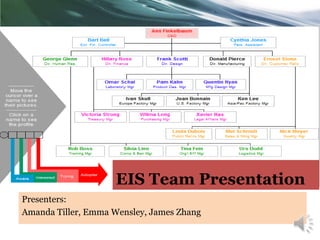
EIS Team Simulation v1.6
- 1. EIS Team Presentation Presenters: Amanda Tiller, Emma Wensley, James Zhang
- 2. Simulation Results We achieved considerable success after 120 days Accepted: 10 Trying: 9 Interested: 4 Aware: 1 From 22 managers, we have 10 “accepted”, and 9 “trying”. Most of the 9 trying are very close to “accepted”.
- 4. Networks (work and non-work)
- 5. Simulation Strategy Diagnostic actions Awareness building actions Interest – building actions Actions to support appraisal/trial Actions that we thought would not be effective
- 6. Implementation Strategy Worked from diagnostic actions to actions to support appraisal/trial Tried to make everyone aware first Utilized many strategic face to face meetings to gain interest and approval Used enthusiastic and influential individuals to help convince others Face to face meetings, pilot tests, workshops, staff meetings, and management training most effective
- 7. Key Lessons Learned • Passive forms of communication are not as effective as personal interactions • Important to learn about individuals prior to attempting to convince them • • Personal relationships are very important Top-down approach was effective, but CEO’s direct reports needed to be convinced first • Focus on innovators, early adopters, and early majority – the rest will eventually follow • Time consuming actions – need time between implementation
- 8. Recommendations • • • Plan implementation strategy Characterize the individuals impacted by the change Leverage influencers Leverage influential individuals
- 9. Implications & Risks Idea Personal Risk Successful implementation Innovation Business Risk •Loss of respect •Lost revenue •Fewer opportunities •Decreased market share •Decreased confidence •Missed opportunities
- 10. Summary • • • Implementation strategy is key Characterize the impacted individuals Understand personal and business risks Implementation planning is just as important as developing the innovative idea
Notes de l'éditeur
- In this project, our team took on the difficult task of implementing EIS at Teleswitches. We had 120 days to change the attitude of the managers towards EIS.At the end of the scenario, we achieved considerable success by converting 10 of the top managers, including the CEO, to “Accepted” status. Overall, 19 of the 22 managers were in “accepted” or “trying” state.
- There were many factors that contribute to success or failure of an action. Not all of them were within our control.Trust – Most of the managers did not trust us at first. It had to be earned over time.Timing – Some of the managers travel, or were very busy. Meeting with them was hit or miss. Timing is outside of our control.Personality – Personalities vary greatly. Some were forthcoming, while others were reserved. Some were very excited to try new things, while others like status quo. We had to learn about each manager and decide who would be a better fit for next action.Work Network Influence – Task force members, and members of the same department, can influence each other’s viewpoints. We observed that when interest level for a key influencer rise, it would raise the interest level of the entire department or team.Informal Network Influence – This works similarly as work network. Utilizing both informal networks gave us the opportunity to influence other departments.
- Both formal and informal networks were extremely important to the simulation. As we can see here, the person with lowest interest level does not belong to any network.
- Diagnostic actions – task forces, coffee breaks, networks, personal profiles, process teamsAwareness building actions – internal magazine, electronic mail, face-to-face meetings, memorandumInterest – building actions – seek advice, face-to-face meetings, management training, workshops, staff meeting discussion, questionnaire, external speakerActions to support appraisal/trial – directors meeting, face-to-face meetings, pilot test, dinner eventActions that we thought would not be effective – directive, covert lobbying
- Worked down the line from diagnostic actions to actions to support appraisal/trial in orderWorked to make everyone aware prior to moving to the next set of actionsAttempted to build as much interest as possible using the enthusiastic and influential individuals to convince others that the EIS implementation was a good ideaUtilized many strategic face to face meetings to gain interest and approval We found face to face meetings, pilot tests, workshops, staff meetings, and management training most effective
- Passive forms of communication are not as effective as personal interactionsImportant to learn about individuals prior to attempting to convince them to adopt your ideaPersonal relationships are very important – important to utilize formal and informal networks to convince peopleTop-down approach was effective, but CEO’s direct reports needed to be convinced before the CEO was convincedFocus on innovators, early adopters, and early majority – the rest will eventually followTime consuming actions – need to take time between implementing them because the business still needs to run while you are trying to implement this innovation.
- Ensure an implementation strategy is developed for an innovationPlan actions for each stage: awareness, interest, trial & adoptionSpend time to understand where each person falls on the diffusion of innovation modelUnderstand who the big influencers are in the organization and leverage their ability
- Risk with Disruptive Innovation
- Every innovation project must have an implementation strategy (must not underestimate)There will always be resistance to change – need to understand the personalities and connections between individualsAll innovation plans have personal and business risks associated with them – need to incorporate mitigation plans